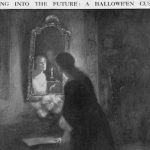
Of witches and witchcraft
As we kick off our Halloween celebrations and delve into the history, contained within the newspapers, of witches and witchcraft (and supernatural beings), it is imperative that we preface this — perhaps unnecessarily — with an important disclaimer and reminder: witches, in the sense of practitioners of malevolent powers to do evil works, never existed. Those persecuted during the sixteenth century and onward were, more often than not, local healers and midwives.
In 1562, Queen Elizabeth passed the law ‘An Act Against Conjurations, Enchantments and Witchcrafts’ that made the practice of such activities punishable by prison time or death (in the instance where death has been caused as a result of said activities).
Witch-hunts were, at times, an extension of the searches for and persecution of recusants/nonconformists, bleeding into the religious restrictions and fervours created from one monarch to the next. Going hand in hand with this, of course, was a limited understanding of illness, diagnosis, and the causes of death. Unknown causes of illnesses and deaths were, therefore, often attributed to the practice of witchcraft.
The accusation of witchcraft was also used as a means of revenge or attention, or, in some instances, a risky way to make a living (either by claiming to be a witch or accusing another).
In the case of the Pendle Witches, we can observe several of these motivations.

The belief in witches is very ancient and was, until a late date, almost universal. Even to-day the belief that some women raise storms is hardly extinct in the north of Scotland (real, meteorological storms, not the other kind!). The Witches’ Sabbath falls on Hallowe’en, October 21, and has an interesting origin. In Druidic mysteries it was held that on that date Saman, Lord of Death, called together the spirits of all the wicked dead who in the last twelve months had been condemned to inhabit the bodies of animals. Hence, no doubt, the animal shapes attributed to the indispensable “familiar spirits” of witches and the habit of witches of turning into hares and such-like. The bonfires of Hallowe’en are distinct from this tradition, being a survival of the Druidic fires lit in honour of the Sun God in thanks for the harvest: it is possible that the fires of November 5 really have their origin here and were only transferred to the unfortunate Guy Fawkes. Witches were always initiated by others and Mr Bestall’s fanciful and attractive picture suggests the novitiate of a young “malefica”.

Explore more witchcraft-related stories
Of werewolves and vampires
Witches were hardly the only supernatural figure to be mythologised and feared.
Pop culture of the last century has been inundated with werewolves and vampires. These creatures of the night have been found in popular books (Dracula, Interview with a Vampire), movies (An American Werewolf in London, Nosferatu), and television shows (Dark Shadows, Vampire Diaries, Teen Wolf).
The mythology of these creatures has long captivated us mere mortals, long before we were swept up in the tales of vampire romance and the drama of teenage werewolves. The mythology and lore of vampires, werewolves, and other nightmare creatures date back hundreds of years and discussion of such beliefs–and their impact on society–has occasionally made headlines in our newspapers.
The following article, ‘The Vampire Superstition’, was printed in 1888 in the Lancashire Evening Post. It details some of the mythology surrounding belief in vampirism including the ways in which to kill a vampire.

In the following account, printed in October 1855, we see how the belief in and superstitions surrounding vampires led to the desecration of a body and the death of a young woman.

As with witches and witchcraft, the susceptibility of a community to believe in the supernatural created a shield for those guilty of crimes. It is, as we’ve seen from our study of witch trials, impossible to disprove satisfactorily an accusation of the supernatural and thus the accusation itself becomes a scapegoat.

Vampires even made their way into the Illustrated Police News. In 1895, an illustration was printed depicting ‘a vampire, murder by a maniac’. In this instance, it was accepted that the murder was committed not by a real creature of the night, but by a mortal man who believed himself to be a vampire.
The curiosity surrounding the existence of vampires did not die in the 1800s. In 1940, a letter was sent into the Daily Mirror enquiring if vampires were real.

Efforts were also made to separate fact from fiction. In 1910, there was published an article in the Graphic detailing the fictional vampire and explaining the ‘genuine’ vampire.
Despite the largely accepted truth today that the vampire, an undead supernatural creature of the night, does not in reality exist, nor that of the shape-shifting werewolf, both are likely to always have a place in popular culture. Thankfully, their presence in the newspapers of today will be confined to reviews of movies, books, and television shows.
What tricks or treats will you find in the newspapers today?









